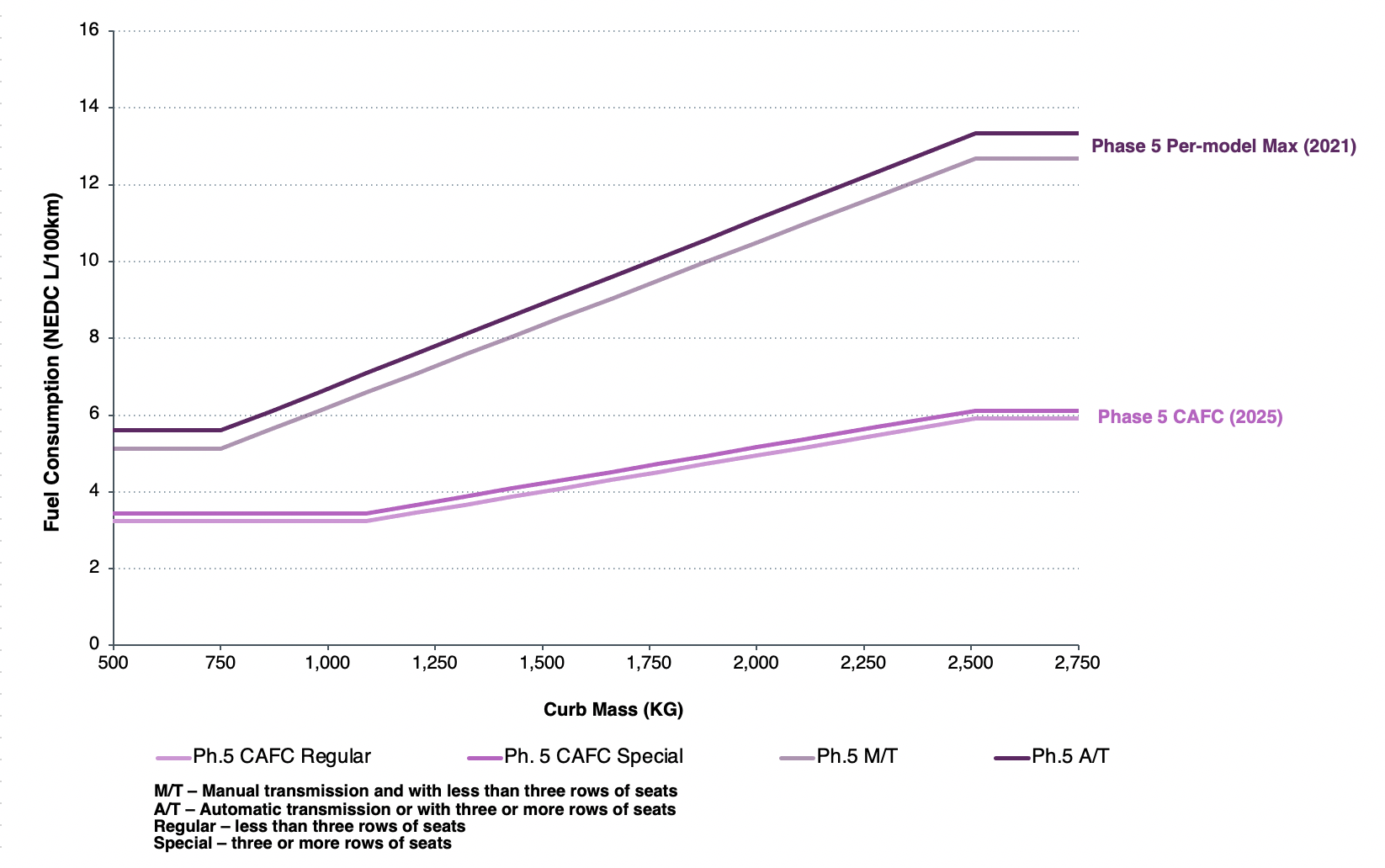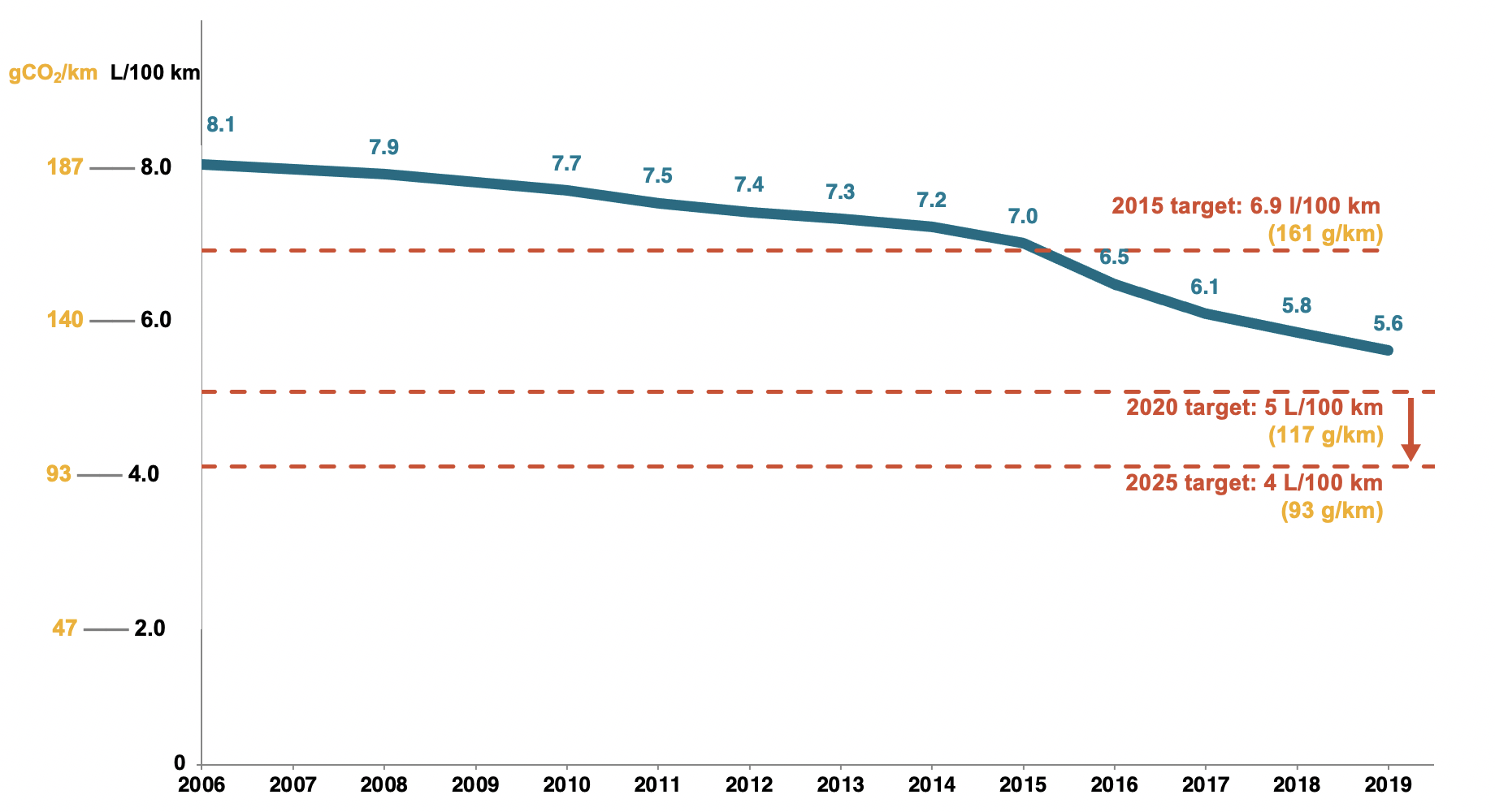Standard type
Fuel consumption limits
Current Standard
Phase V standards:
GB 19578-2021 (per-model standard)
GB 27999-2019 (corporate average fuel consumption standard)
Applicability
– Vehicle size: ≤ 3,500 kg (max designed gross vehicle weight), 9 or fewer seats
– Production: domestic or imported
History
Phase I and II
China’s first-ever compulsory fuel consumption standard for passenger vehicles was issued in 2004 (National Standard GB 19578-2004). It established Phase I and Phase II fuel consumption standards, which were enforced for newly certified models in 2005 and 2008, respectively (2006 and 2009 for continued models, i.e., models that already had certification before government issue of the standard). Phase I and II standards were per-model standards, requiring each vehicle model to comply with fuel consumption regulations before entering the market. This contrasts with policies in the U.S., the EU, and Canada, which permit auto manufacturers to meet targets by averaging emissions over their entire fleet of models.
Phase I standard applied to passenger vehicles with over 50 km/h maximum designed speed, excluding compressed natural gas, liquefied natural gas, liquefied petroleum gas, and alcohol ether fuel vehicles. This standard was broken down into 16 curb mass classes, with maximum fuel consumption limits differentiated by transmission and the row number of seats. The Phase I standard was enforced in July 2005 for all new vehicle models (2006 for continued models).
Phase II standard had a similar structure as Phase I but tightened the maximum fuel consumption limits by approximately 10%. This second round of regulations was enforced in January 2008 (2009 for continued models).
Phase III
Phase III fuel consumption standards for passenger vehicles consisted of two parts: a per-model standard (GB 19578-2004) and a corporate average fuel consumption standard (GB 27999-2011).
The CAFC standard (GB 27999-2011), issued in 2011 and enforced in 2012, was a new scheme in China’s fuel consumption regulatory history. It established new CAFC targets for auto manufacturer and importer compliance, as well as a timeline for this compliance, in addition to the per-model standard. There was also an average fleet target goal for new passenger vehicles produced or imported by 2015: approximately 7 L/100 km (equivalent to 167 g CO2/km). The maximum fuel consumption limits of the per-model standard for Phase III and Phase II are equivalent.
In 2012, China’s State Council released the Energy-Saving and New Energy Vehicle Industrialization Plan (2012–2020) in which states an expected average fleet target of 6.9 L/100 km for passenger vehicles by 2015 (slightly below the estimate in GB 27999-2011) and 5.0 L/100 km by 2020. In 2013, five government departments issued the Corporate Average Fuel Consumption Evaluation Methods for Passenger Cars, which reconfirmed the expected fleet fuel consumption targets of 6.9 and 5.0 L/100 km.
Phase IV
Phase IV fuel consumption standards for passenger vehicles (GB19578-2014, GB 27999-2014) were released together in 2014 and enforced in 2016. GB19578-2014 determined the maximum fuel consumption limits for vehicle models, whereas GB 27999-2014 determined the maximum fuel consumption limits for the corporate average fuel consumption (CAFC) of auto manufacturers and importers.
Similar to the previous phases of standards, GB19578-2014 set per-model standard indexed to 16 vehicle curb mass classes, excluding compressed natural gas, liquefied natural gas, liquefied petroleum gas, and alcohol ether fuel vehicles. But this per-model standard tightened the maximum fuel consumption limits by approximately 20 percent from Phase III (GB19578-2004).
Unlike the previous phase, Phase IV CAFC standard (GB 27999-2014) expanded its regulatory scope to include plug-in EVs, FCVs, as well as compressed natural gas, liquefied natural gas, and liquefied petroleum gas vehicles. It set an average fleet target of about 5.0 L/100 km for new passenger vehicles in 2020. The standard offered two aspects of compliance flexibility: 1) A phase-in schedule for full compliance, and 2) Fuel consumption credits (no more than 0.5 L/100 km) for adopting off-cycle technologies, including start-stop, tire pressure monitoring systems, gear shift indicators, and efficient A/C systems.
Phase V
Phase V fuel consumption standards for passenger vehicles (GB 19578-2021, GB 27999-2019), were issued at different times but share the same effective year: 2021. These revolutionary standards were created based on the Worldwide harmonized Light-duty Test Cycle (WLTC) instead of the previously used New European Driving Cycle (NEDC). Another significant change was that the calculation method for maximum fuel consumption limits evolved from the weight-class approach into a weight-based linear regression. The Phase V standards also added referral indexes for calculating CO2 emissions for gasoline and diesel vehicles.
Due to the transition from NEDC to WLTC, the absolute values of fuel consumption limits in the Phase V per-model standard (GB19578-2021) appear loosened from Phase IV limits for vehicle models with the same curb mass. Test results showed the absolute fuel consumption values under WLTC are about 10% higher than that under NEDC, and as the curb mass increases, the differences can be even higher.
GB 27999-2019, the CAFC standard in Phase V, further expanded its regulation scope to alcohol ether fuel vehicles based on Phase IV. It set the NEDC average fleet target of 4.0 L/100 km for all new passenger vehicles by 2025, providing a similar phase-in schedule and compliance flexibility as Phase IV.
See below figures for more information:
Figure 1. Phase V fuel consumption standards under NEDC. Since the Phase V standards were set under WLTC, conversions from WLTC to NEDC were made using ICCT conversion factors.
Figure 2. Passenger vehicle fuel consumption historical trend and targets.


Technical Standards
Fuel Consumption Standards
Before Phase V, the per-model standard and CAFC standard both adopted a weight-class system, which sets discrete values for maximum fuel consumption limits according to 16 vehicle curb mass classes. A weight-based linear regression method was adopted from Phase V, allowing continuous values for maximum fuel consumption limits to be calculated based on vehicle curb mass. The maximum limits from Phase I to IV were set under NEDC, while the Phase V limits are under WLTP. Fuel consumption data tested by certified laboratories are reported to China’s Ministry of Industry and Information Technology (MIIT) by auto manufacturers.
Chinese fuel consumption standards for passenger vehicles are summarized in the following table. The effective dates refer to new models. The dates for continued models were one year later for Phase I to Phase III, and two years later for Phase IV and V.
| Curb Mass (CM) | Per-M-1, Phase I: 2005 (NEDC) |
Per-M-S, Phase II: 2008 (NEDC) |
CAFC-S2, Phase III: 2012 (NEDC) |
CAFC-S, Phase IV: 2016 (NEDC) |
Per-M-S, Phase V7: July 1, 2021 (WLTC) |
CAFC-S, Phase V: Jan 1, 2021 (WLTC) |
||||||
| Per-M-S, Phase III: 2012 (NEDC) |
Per-M-S, Phase IV: 2016 (NEDC) |
|||||||||||
| Kg | M/T3 | A/T4 | M/T | A/T | M/T | A/T | Reg5 | Special6 | M/T | A/T | Reg | Special |
| CM ≤ 750 | 7.2 | 7.6 | 6.2 | 6.6 | 5.2 | 5.6 | 4.3 | 4.5 | 5.82 | 6.27 | 4.02 | 4.22 |
| 750 < CM ≤ 865 | 7.2 | 7.6 | 6.5 | 6.9 | 5.5 | 5.9 | 4.3 | 4.5 | 0.0041x(CM-1415)+8.55 | 0.0042x(CM-1415)+9.06 | ||
| 865 < CM ≤ 980 | 7.7 | 8.2 | 7 | 7.4 | 5.8 | 6.2 | 4.3 | 4.5 | ||||
| 980 < CM ≤ 1,090 | 8.3 | 8.8 | 7.5 | 8 | 6.1 | 6.5 | 4.5 | 4.7 | ||||
| 1,090 < CM ≤ 1,205 | 8.9 | 9.4 | 8.1 | 8.6 | 6.5 | 6.8 | 4.7 | 4.9 | 0.0018x(CM-1415)+4.6 | 0.0018x(CM-1415)+4.8 | ||
| 1,205 < CM ≤ 1,320 | 9.5 | 10.1 | 8.6 | 9.1 | 6.9 | 7.2 | 4.9 | 5.1 | ||||
| 1,320 < CM ≤ 1,430 | 10.1 | 10.7 | 9.2 | 9.8 | 7.3 | 7.6 | 5.1 | 5.3 | ||||
| 1,430 < CM ≤ 1,540 | 10.7 | 11.3 | 9.7 | 10.3 | 7.7 | 8 | 5.3 | 5.5 | ||||
| 1,540 < CM ≤ 1,660 | 11.3 | 12 | 10.2 | 10.8 | 8.1 | 8.4 | 5.5 | 5.7 | ||||
| 1,660 < CM ≤ 1,770 | 11.9 | 12.6 | 10.7 | 11.3 | 8.5 | 8.8 | 5.7 | 5.9 | ||||
| 1,770 < CM ≤ 1,880 | 12.4 | 13.1 | 11.1 | 11.8 | 8.9 | 9.2 | 5.9 | 6.1 | ||||
| 1,880 < CM ≤ 2,000 | 12.8 | 13.6 | 11.5 | 12.2 | 9.3 | 9.6 | 6.2 | 6.4 | ||||
| 2,000 < CM ≤ 2,110 | 13.2 | 14 | 11.9 | 12.6 | 9.7 | 10.1 | 6.4 | 6.6 | ||||
| 2,110 < CM ≤ 2,280 | 13.7 | 14.5 | 12.3 | 13 | 10.1 | 10.6 | 6.6 | 6.8 | ||||
| 2,280 < CM ≤ 2,510 | 14.6 | 15.5 | 13.1 | 13.9 | 10.8 | 11.2 | 7 | 7.2 | ||||
| 2,510 < CM | 15.5 | 16.4 | 13.9 | 14.7 | 11.5 | 11.9 | 7.3 | 7.5 | 13.04 | 13.66 | 6.57 | 6.77 |
| (1) Per-M-S: per-model standard (2) CAFC-S: corporate average fuel consumption standard (3) M/T: manual transmission and with less than three rows of seats (4) A/T: automatic transmission or with three or more rows of seats (5) Reg: less than three rows of seats (6) Special: three or more rows of seats (7) The maximum limits for Phase I–IV are under NEDC, while the maximum limits for Phase V are under WLTP |
||||||||||||
Corporate Average Fuel Consumption (CAFC) Standards
The Corporate Average Fuel Consumption (CAFC) is a metric that describes the average fuel consumption of all passenger vehicles produced or imported by an auto company. From Phase III onward, China’s fuel consumption regulations for passenger vehicles encompass both maximum fuel consumption limits for vehicle models (per-model standard) and corporate average fuel consumption (CAFC) limits for each auto company based on vehicle curb mass distribution. Auto manufacturers and importers must meet both criteria simultaneously. That is, for each calendar year, each vehicle model produced or imported must meet the per-model standard and each auto company’s passenger vehicle fleet must meet the CAFC requirements. The formula for calculating the actual CAFC is as follows:

Vehicles with lighter fuel consumption are assigned with heavier weights in the CAFC calculation, resulting in greater multipliers in the formula mentioned above, with gradually decreasing weights. For example, the multiplier for passenger BEV, FCV, and PHEV models with a pure electric range of 50 km or more is counted as 2.0 () in 2021 but decreases to 1.0 () in 2025. The multiplier for models with fuel consumption lower than 3.2 L/100 km is counted as 1.4 ( but decreases to 1.0 () in 2025, too. This flexibility is intended to incentivize energy-efficient vehicles, such as BEVs, FCVs, and PHEVs while continuing to allow the production of less energy-efficient gasoline vehicles.
CAFE AND NEW-ENERGY VEHICLE (NEV) MANDATE POLICY
The Management Regulation for Corporate Average Fuel Consumption (CAFC) and New Energy Vehicle (NEV)[1] Credits, also known as the dual credit policy, sets both CAFC targets and new energy vehicle (NEV) targets for auto companies that produce or import passenger vehicles (similar to California’s ZEV mandate policy). Compliant parties will have positive or neutral CAFC and NEV credits. CAFC credits are calculated by the differences between CAFC targets (TCAFC) and the actual CAFC (ACAFC), multiplying the number of vehicles been produced or imported. On the other hand, NEV credits are the differences between the actual NEV score (ANEV) and the NEV targets (TNEV). ANEV is defined as the number of NEVs produced or imported multiplying a per-vehicle NEV credit. The per-vehicle NEV credit varies among different NEV types (EVs, PHEVs, FCVs), which depends on NEV electric range or rated power. TNEV is the company’s annual conventional-fuel passenger car production or import multiplied by a required NEV percentage target (see details in the last paragraph of this section).
The first CAFE and NEV Mandate Policy was released in 2017, which articulates that the NEV percentage requirements for 2019 and 2020 are 10% and 12%. Before this release, there were two draft versions for public review in 2016 and 2017. Moreover, auto companies with less than 30,000 traditional passenger vehicle production or import volume are not required to meet NEV targets.
In 2019, MIIT announced its decision to revise the dual credit policy and released the amendment in 2020. This amendment sets NEV percentage requirements for 2021–23 as 14%, 16%, and 18%, respectively. Similarly, NEV multipliers vary among different NEV types, but minor changes have been made (e.g., the multiple for per-PHEV is now 1.6 instead of 2).
[1] In the Chinese context, new energy vehicles (NEVs) refer to battery electric vehicles (BEVs), plug-in hybrid electric vehicles (PHEVs; extended-range electric vehicles included), and fuel cell electric vehicles (FCVs).
LIGHT COMMERCIAL VEHICLES
China’s first national compulsory fuel consumption standard for light commercial vehicles (GB 20997-2007), released in 2007, sets the Phase I and Phase II standards for vehicle models based on vehicle weight, fuel type (gasoline and diesel), and engine displacement. This standard took effect in 2008, then was replaced by the Phase III standard (GB 20997-2015) in 2018. The Phase III standard set maximum fuel consumption limits for vehicle models based only on vehicle weight and fuel type, with 12 more weight classes than former phases. Currently, the Phase IV standard for light commercial vehicles is under development. While the details have not yet been released (as of March 2021), both the per-model and corporate average fuel consumption limits are projected to be stricter.


